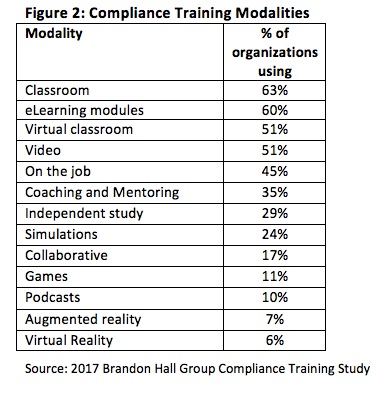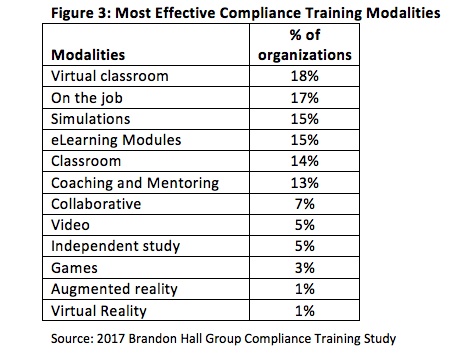
Compliance training affects just about every organization around the world. It can comprise anything from a review of the employee manual to training on critical life-or- death issues. In Brandon Hall Group’s 2017 Training Benchmarking Study, respondents indicated that, on average, compliance training accounts for 11 percent of the Learning and Development (L&D) budget. Failure to execute effectively could result in anything from a sternly written letter to the end of the business.
Yet, despite its reach and implications, many organizations struggle to develop ways to make this training more engaging and strategic. Brandon Hall Group’s 2017 Compliance Training Study found that only about one-third of companies consider their compliance training efforts to be effective. Most report that their efforts are only somewhat effective.

While only approximately 4 percent of companies say their compliance efforts are not effective, the truth is that “somewhat effective” is not necessarily that much better when it comes to compliance. When it comes to safety, the law, or life and limb, “somewhat” is often not enough. For a majority of companies, there is a significant gap in how well they deliver compliance training compared to other types of learning.
On average, 45 percent of compliance training is driven by external agencies. For companies in high-consequence industries (manufacturing, finance, health care, etc.), which face significantly more regulatory pressure, the need to satisfy external requirements is even greater.
Organizations need to rethink the systems and modalities with which they are delivering compliance training, the content they are using, and essentially the organizational view of compliance training in general.
Top Research Findings
1. Compliance training remains traditional, but there are signs of change. Brandon Hall Group research shows that about 85 percent of companies have at least one learning management system (LMS) in house to manage learning. However, an LMS is used to manage less than two-thirds of all compliance training.
The real story here is that nearly a quarter of all compliance training activities are manually managed. That means that organizations track a critical piece of the business with spreadsheets, mail, and intranet sites. This could be one reason so few companies find their compliance training to be highly effective. In fact, companies that say their compliance efforts are not effective manually manage 36 percent of compliance training; companies reporting effective compliance training only manually manage 20 percent of it.
Manual management of critical compliance and regulatory training opens the door to many risks. It is typically more challenging to keep these types of processes up to date to ensure that the right training reaches the right people and is properly recorded. Many companies do this manually because they have always done it that way and fear change will lead to even worse results.
At the same time, other organizations embrace technology to deliver compliance training. Of course, the most common methods remain in-person instructor-led classroom training and e-learning modules, but we see growing adoption of many other tools, including virtual classrooms, video, and simulations.

This data shows that the environment for compliance training has expanded since it was just classrooms and e-learning. Not too long ago, using games for compliance would be unheard of, yet now 11 percent of companies use them. One-quarter of companies use simulations, and 17 percent have found ways to let learners collaborate for more informal, social compliance training.
Although it is the most commonly used method of compliance training, in-person classrooms are not considered the most effective. That honor belongs to virtual classrooms. In fact, on-the-job-training, simulations and e-learning all rated higher for effective compliance training than the traditional classroom.

Given these modalities are considered effective, it makes sense that 45 percent of companies say they will use more simulations in the future, and 44 percent say the same for virtual classrooms. Only one-quarter say they will use more classroom training. However, there will be a boost in the use of video, as 48 percent of companies plan to use more of it for compliance training. Even virtual and augmented reality—tools that have yet to find a lot of traction in learning in general—will see growth; 13 percent of companies plan to increase the use of both.
2. Most compliance training is created in-house. Where do companies get all the compliance content that is being delivered via these methods? More than half create it themselves. Despite myriad providers in the market, including training companies, content libraries, and regulatory agencies, 57 percent of the content being used is developed in-house.
This is because companies don’t find content from external providers all that effective. Just 31 percent of companies chose third-party providers as the source of the most effective compliance training content, while 62 percent say their own material is the most effective.
When companies do reach outside for compliance content, they look for customized content that meets their unique needs. Despite the reservations about external content, the research shows a majority of companies plan to use third-party content more often in the future.

3. Only 40 percent of companies are thoroughly prepared for an audit. Almost all organizations face a compliance audit at some point, even those that aren’t in a highly regulated industry. Sometimes the audit comes from within, other times it can come from an outside agency. In fact, 93 percent of companies overall say they conduct an internal compliance audit at some point, and more than 80 percent face audits from external agencies. Unfortunately, those companies are not fully prepared when those audits come.

Only 40 percent of companies say they are thoroughly prepared for an audit by an external agency. More than half say they are somewhat prepared, but the reality is that somewhat prepared may as well be not at all. If a company is only somewhat prepared, there are gaps somewhere that need to be addressed, and the outcomes of the audit are going to be less than satisfactory.
Among those companies that report their compliance efforts are effective, 69 percent say they are thoroughly prepared, while that number is just 24 percent for those with somewhat effective or ineffective compliance training. This challenge is exacerbated by the fact that many organizations can’t be sure when they are going to be audited.

For those companies that face external audits, 31 percent say they come on an ad hoc basis. They may be scheduled, but there is no particular cadence to guide the preparation for the audit. Some 8 percent of companies that face audits face them quarterly, which means that despite being scheduled, they can come up quickly. In any case, a process for getting and staying prepared is critical to make sure audits turn out well.
4. Employees typically spend fewer than 25 hours per year in compliance training. Getting prepared for an audit or simply ensuring the organization is in compliance does not necessarily mean pushing for more time in compliance training. Overall, the study found that 80 percent of companies have their employees spending fewer than 25 hours a year in compliance training.
These numbers do not significantly change when we look at how prepared companies are for an audit. Those that are prepared, and those that are not, report similar time spent in training. The volume of training also does not significantly change when we compare companies that report their compliance training as effective to those that say it is not.

Regardless of effectiveness or preparedness, companies broke down with similar averages for how often employees participate in compliance training. The most common cadence is annually, with more than one-third of companies making compliance training a yearly event. These benchmarks suggest that the basic mechanics of compliance training—frequency and quantity—have no real impact on its outcomes.
Takeaways
Compliance training no longer can be seen as a “check-the-box” exercise. A strong commitment to compliance translates into a better, safer workplace where people are better at their jobs. It also can make a company stand out as an employer of choice by creating a better work environment, demonstrating that the employees’ health and well-being are important, or even making the company known for “doing the right thing.”
Data shows that companies are unprepared to deliver effective compliance training that meets the requirements of a formal audit—internal or external. But simply throwing compliance training at employees more frequently is not the answer. There has to be a shift in how companies look at compliance training. If checking the box is not having the desired outcomes, it is time to start with those outcomes and design and deliver learning around them. This is how most other forms of organizational learning are approached, but not compliance.
Organizations have a whole host of new technologies available to them to deliver compliance training, as well as multiple sources of high-quality content that is ready to go. Bringing compliance training into the overall learning strategy will help improve effectiveness and the impact on compliance outcomes.
Some of the key considerations for compliance training include:
- Governance. Get a team together from different parts of the organization that can focus on getting compliance right.
- Content. Use what works. Compliance training already is branded as being boring, so don’t exacerbate the problem by using boring formats. Engage with videos, simulations, and interactive e-learning. Seek external expertise.
- More is not more. Be judicious with the frequency and quantity of compliance training. If goals are not being met, more training is probably not the answer. Better training focused on outcomes is.
- Preparation. Don’t look at compliance as an annual event that takes place right before the audit. The audit isn’t actually the end goal. The end goal is safety for workers, safety for consumers, and adherence to the law. Taking a more strategic view will make compliance training more effective and render concern over audit preparedness unnecessary.
- Systems. Find or build a system to manage all the various aspects of compliance. If some of it lives with legal, some with finance, and the rest somewhere else, it can be difficult to get everyone on the same page. A single platform that allows all the functions to integrate their compliance needs will work far better than reams of paper and filing cabinets.
David Wentworth is principal Learning analyst at Brandon Hall Group, an independent research/analyst firm in the human capital management market. The firm’s vision is to inspire a better workplace experience, and its mission is to empower excellence in organizations around the world through its research and tools. Brandon Hall Group has five HCM practices, produces the Brandon Hall Group Excellence Awards and the annual HCM Excellence Conference, held Jan. 30-Feb. 2, 2018, in Palm Beach Gardens, FL.



